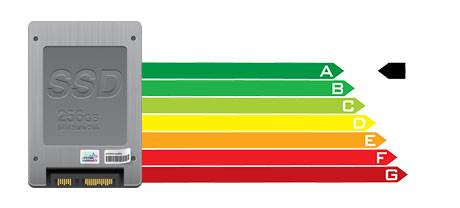For decades there was just one reliable way for you to store info on a personal computer – employing a hard drive (HDD). However, this kind of technology is actually demonstrating it’s age – hard disk drives are actually loud and slow; they are power–hungry and tend to create a great deal of heat for the duration of serious procedures.
SSD drives, on the other hand, are swift, use up a lesser amount of power and are also much cooler. They feature a completely new way of file access and storage and are years ahead of HDDs regarding file read/write speed, I/O efficiency and also power capability. Observe how HDDs fare up against the modern SSD drives.
1. Access Time
After the launch of SSD drives, file accessibility rates are now through the roof. With thanks to the completely new electronic interfaces utilised in SSD drives, the regular file access time has been reduced towards a record low of 0.1millisecond.
The technology driving HDD drives goes all the way back to 1954. And even while it has been significantly enhanced through the years, it’s nonetheless no match for the imaginative ideas powering SSD drives. Using today’s HDD drives, the highest file access rate you are able to reach varies between 5 and 8 milliseconds.
2. Random I/O Performance
Thanks to the very same revolutionary strategy that enables for speedier access times, also you can appreciate better I/O effectiveness with SSD drives. They will accomplish two times as many operations during a given time in comparison to an HDD drive.
An SSD can manage at the least 6000 IO’s per second.
Hard drives provide reduced file access speeds due to the aging file storage and accessibility technology they’re making use of. And in addition they illustrate noticeably reduced random I/O performance as opposed to SSD drives.
During GlobalVisions.ca’s lab tests, HDD drives managed on average 400 IO operations per second.
3. Reliability
SSD drives don’t have just about any rotating elements, meaning that there is a lesser amount of machinery within them. And the less actually moving components you will find, the lower the probability of failing will be.
The standard rate of failure of an SSD drive is 0.5%.
Since we already have mentioned, HDD drives make use of spinning disks. And something that takes advantage of a number of moving components for continuous time periods is more likely to failure.
HDD drives’ common rate of failing can vary among 2% and 5%.
4. Energy Conservation
SSD drives function nearly noiselessly; they don’t generate excess warmth; they don’t require extra chilling options and take in way less electricity.
Lab tests have shown that the common power usage of an SSD drive is amongst 2 and 5 watts.
HDD drives are renowned for staying loud. They demand more electrical power for air conditioning reasons. With a server which has a variety of HDDs running all of the time, you need a great number of fans to keep them kept cool – this may cause them far less energy–efficient than SSD drives.
HDDs take in in between 6 and 15 watts.
5. CPU Power
SSD drives enable a lot faster data access rates, which, consequently, encourage the CPU to accomplish file requests much quicker and afterwards to go back to additional tasks.
The regular I/O wait for SSD drives is exactly 1%.
When you use an HDD, you will need to dedicate additional time anticipating the results of your data query. As a result the CPU will stay idle for more time, waiting for the HDD to respond.
The common I/O delay for HDD drives is about 7%.
6.Input/Output Request Times
The bulk of our brand new machines now use only SSD drives. All of our tests have established that having an SSD, the normal service time for an I/O request whilst building a backup stays below 20 ms.
Throughout the identical tests sticking with the same hosting server, now installed out utilizing HDDs, functionality was considerably slow. Throughout the hosting server back up procedure, the standard service time for any I/O demands fluctuated between 400 and 500 ms.
7. Backup Rates
Another real–life advancement is the rate with which the data backup has been made. With SSDs, a web server backup currently can take only 6 hours by using our server–designed software.
Over time, we’ve worked with mainly HDD drives on our servers and we’re knowledgeable of their general performance. On a web server furnished with HDD drives, a complete hosting server backup typically takes around 20 to 24 hours.
The Linux shared hosting packages accounts offer SSD drives by default. Be a part of our GlobalVisions.ca family, to see the way we can assist you boost your website.
Hepsia
- Live Demo
Service guarantees
- Register today. There aren’t any configuration rates and you will have full root access to your server. 99.9% network availability is guaranteed.
Compare our prices
- Preview the allocations and capabilities coming with our Virtual Private Servers. You can start with a smaller VPS Web Hosting package and move up with only a click of the mouse as your demands grow.
- Compare our hosting plans
Contact Us
- Get in touch with us around the clock by email or by making use of GlobalVisions.ca’s ultra–fast ticketing platform. Our technicians are ready to answer any of your queries within 60 mins.














